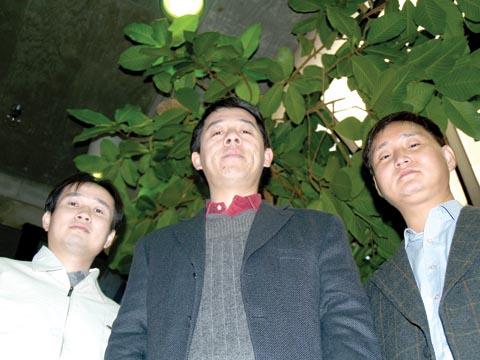| |
|
|

from the issue of December 14, 2006
|

| |
|
|
| |
Project uncovers DNA-like ice structures

BY TOM SIMONS, UNIVERSITY COMMUNICATIONS
Working the frontier between chemistry and physics, Xiao Cheng Zeng has grown accustomed to discovering the unexpected through computer modeling.

| | 
 
| | | RESEARCH GROUP - Members of the UNL research group that discovered the nano-ice double helix are (from left) doctoral candidate Juan Wang, chemistry professor Xiao Zeng and post-doctoral student Jaeil Bai. Photo by Troy Fedderson/University Communications.

|
Regularly, Zeng and his colleagues find new - often unanticipated - behaviors of matter in extreme environments. Their discoveries have been published several times in international scientific journals. However, those findings have been ahead of existing technology and immediate practical impact was essentially nil - until now.

Zeng and two members of his team have discovered double helixes of ice molecules. Resembling the structure of DNA, the molecules self-assemble under high pressure in carbon nanotubes.

The discovery could have major implications for scientists in other fields that study protein structures that cause diseases such as Alzheimer's and mad cow. It may also help guide those searching for ways to target or direct self-assembly in nanomaterials and predict the kind of ice that may be found on Mars and moons in the solar system.

Zeng, post-doctoral student Jaeil Bai and doctoral candidate Jun Wang reported the findings in the Dec. 11-15 online edition of the Proceedings of the National Academy of Sciences.

 
| | COMING TOGETHER - This computer image demonstrates how the nano-ice double helix forms. Oxygen atoms are blue in the inner helix, purple in the outer helix. The hydrogen atoms are white.

| |
The team found the self-assembling double helix of nano-ice following a months-long experiment on UNL's PrairieFire supercomputer.

The experiment was a follow-up on a 2001 discovery in which Zeng, working with another team, modeled four new kinds of one-dimensional ice inside carbon nanotubes. Scientists elsewhere confirmed through laboratory experiment the existence of three of the new nano-ices. One result in particular intrigued Zeng, Bai and Wang. Scientists at Argonne National Laboratory near Chicago confirmed the existence of a chain of octagon-shaped ice crystals inside a 1.4-nanometer carbon tube, just as Zeng and company expected. But the Argonne group also found an additional, unexpected chain of water molecules.

Zeng said that report inspired another look at one-dimensional ice, but this time with a PrairieFire that was 20 times more powerful that it had been five years earlier. The 2001 results were achieved at atmospheric pressures, but PrairieFire's added processing power enabled Zeng, Bai and Wang to design simulations that greatly increased the pressure on the water molecules.

"We were shocked to see these molecules arrange themselves in this way," said Zeng, university professor of chemistry. "We thought it would be like two tubes, one inside the other, but it didn't do that. It was helical, like DNA. I'm speculating, but maybe the helix is a way for molecules to arrange themselves in a very compact, efficient way under high pressure.

"This ice formation can be viewed as a self-assembling process, and self-assembly is a way for molecules to bond together through weak hydrogen bonds. One example of a self-assembling material is protein. Proteins can self-assemble into structures like amyloid fibrils that can build up in the brain to cause Alzheimer's disease or prions that cause mad cow disease."

Another implication, Zeng said, is that these self-assembling helical ice structures may give scientists and engineers a different way to think about weak molecular bonds and the self-assembly process as they try to develop ways to direct self-assembly in making new materials.

He said that while scientists have a good understanding of covalent bonds (the strong type of bonding where atoms share electrons), knowledge is not as complete about the weak bonds, such as hydrogen bonds, that are essential to the self-assembly process.

"We're happy to see potential applications that can maybe advance some fundamental science," Zeng said. "We're not engineers in direct contact with technology, but if our research can make some contribution, we're happy."

Zeng and his colleagues achieved their results by running four series of molecular dynamics simulations on PrairieFire and Department of Chemistry computers, using simulated carbon nanotubes ranging in diameter from 1.35 to 1.9 nanometers. They used Earth-like temperatures ranging from 117 degrees Fahrenheit to 9 degrees below zero F., but with pressures ranging from 10 to 40,000 atmospheres, with each series lasting no more than a few 10s of nanoseconds.

Most of the experiments produced the expected tubular structures, but in a simulation in a 1.35-nanometer tube at minus-9 degrees F. and 40,000 atmospheres, the ice transformed into a braid of double helix that resembles DNA in structure and in the weak bonds between the helixes. Additionally, in a simulation in a 1.9-nanometer tube at the same temperature, pressure on the confined liquid water was instantly raised from 10 atmospheres to 8,000. The confined liquid froze spontaneously into a high-density, triple-walled helical structure.

This research was funded by the Department of Energy, the National Science Foundation, the Nebraska Research Initiative and the John Simon Guggenheim Foundation.
GO TO: ISSUE OF DECEMBER 14
NEWS HEADLINES FOR DECEMBER 14
Project uncovers DNA-like ice structures
Gifts of Love offers opportunity
Sen. Hagel to address graduates
UNL prof testifies against Hussein
Carr, Stump knighted by French government
Group studies Great Plains fire history begins
Housing puts lottery system into play
Quality indicators track UNL progress
Student depth reporting team headed to Berlin
732659S36529X
|
|
|
|
|
|
|
|